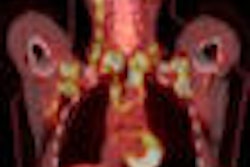So far, much of the recent attention toward reducing pediatric radiation dose has focused on CT. But nuclear medicine is also an area where radiation dose can be better tailored to the specific needs of children, according to members of a Society for Pediatric Radiology (SPR) working group tasked to address the issue.
The SPR's dose working group recently sent out a survey to hospitals asking for information about their use of radiopharmaceuticals for imaging kids. The survey revealed that there are significant differences in how the hospitals calculate dosing for those studies -- all of which turned out good quality images.
"The question is, of all the dosages, which result in the lowest radiation exposure and turn out usable, reliable images," said Dr. Ted Treves, chief of nuclear medicine at Children's Hospital Boston in Massachusetts. "We want to try to reduce the broad range to a narrower range."
Treves and members of the dose working group presented preliminary findings at the SPR's recent annual conference in Carlsbad, CA. The panel's goal is to put together recommendations that can be distributed to SPR members for the best possible doses for safety and image quality. The group will meet again in June, at the Toronto meeting of the SNM, and hope to make preliminary recommendations by the end of the year, Treves said.
The survey was sent to eight children's hospitals and three university hospitals, asking about dosages for approximately 20 radiopharmaceuticals in 16 commonly performed procedures. The panel chose bone scintigraphy and oncology because there are fewer variables in technique and administered activities, and the scans involve the whole body, with or without tomography.
"We are starting with simpler protocols to try to solve methodology and form consensus," said Dr. Michael Gelfand, chief of the nuclear medicine section of Cincinnati Children's Hospital in Ohio. "We'll tackle the more complex problems after we have some consensus."
Panelists emphasized that there are not consistent, science-based recommendations for how the drugs-and-imaging combinations should be used. Most of the radiopharmaceuticals don't have package inserts with dose recommendations. And current literature suggests several different approaches to calculating dose, including body weight, body surface area, the Webster formula, and European Association of Nuclear Medicine (EANM) guidelines. All of the formulas are based on adult doses and settings and, thus, might be higher than necessary, participants noted.
Nine copies of the survey were completed and returned. Survey questions asked the radiology departments what dose per kilogram the hospital uses for kids, as well as the maximum and minimum administered dose.
Many respondents reported relying on weight-based doses that result in the least radiation exposure for many procedures. The body-surface-area formula yields exposure notably higher than the weight-based protocol.
"The dose is 33% higher for a 10-year-old, 72% higher for a 5-year-old, and 94% higher for a 1-year-old," Gelfand said. "The Webster formula doses are about a 30% difference."
While many hospitals could name their method, others had different explanations.
"There's also the 'it-was-here-when-I-started' method," Gelfand said. "That's somebody using a weight table taped up on a wall."
The survey showed variations of more than 100% in radiation dose and exposure.
"I never realized the size and range of administered activities until I saw the result of Dr. Treves' survey," Gelfand said. "I was a little bothered by it."
For several radiopharmaceuticals, nearly all the hospitals rely on weight-based protocols, and there was little variation in doses. Regarding the widest range of doses, Gelfand said one radiopharmaceutical stands out: technetium-99m (Tc-99m) dimercaptosuccinic acid (DMSA). "We're all over the place on this one," he said.
As a result, the panel hopes to make recommendations for using Tc-99m DMSA, along with fluorine-18 FDG, iodine-123 metaiodobenzylguanidine (MIBG), and Tc-99m methylene diphosphonate (MDP), in time for the Toronto SNM meeting. The panel members will then select three more radiopharmaceuticals to study and make recommendations for, Gelfand said.
The $64,000 question for dose change is simple: Do we really need more radiopharmaceutical activity to get the same count density in smaller children? "The answer seems to be not really or not very much," Gelfand said.
Panelists at the SPR discussion showed a series of studies performed with different scanner settings, some using 3D reconstruction. Although there were variations in image density of image and noise, nearly all the images were deemed acceptable -- and some studies with lower doses or exposures yielded better information than those with more radiation risk to children.
Ultimately, more thought should go into planning scans, Gelfand said. Sometimes, no useful information is acquired in the later of a series of scans. And sometimes useful information is acquired at higher doses.
"We have to come to conclusions that allow people to have some variability in their studies, good quality in their studies, and that keep the administered activity down," Gelfand said. "That will be our challenge."
Treves noted that survey answers that seemed unusually high or low were verified with the hospitals that sent them in. Only one unnamed hospital was willing to consider changing their protocols to a straight weight-based formula, Gelfand noted, although the lower dose resulted in almost identical pixel counts.
While it's too early to make recommendations for formulae and doses, Gelfand said, the panel offered some take-home suggestions for the time being:
- Exposure from body-surface-area-derived administered activities (and related formulas) is considerably higher than exposure from weight-based activities in small children.
- The EANM dose-card-administered activities are slightly higher than weight-based activities.
- Don't try to solve potential movement issues with higher administered activities; look at sedation or restraint techniques instead.
- Review the adult dose basis used in your administered activity calculations and see if it is higher than needed for your pediatric patients.
- Are any administered activities higher than needed to facilitate flow studies of questionable value?
- How does your time per frame relate to the actual time of occurrence of physiologic events?
- Can you acquire at a faster time per frame and reframe at a slower time per frame for your dynamic time activity curves and sequential images?
- Consider using the PET 3D scanner when such imaging is needed, as recommended by the EAMN.
By Marty Graham
AuntMinnie.com contributing writer
May 22, 2009
Related Reading
SPECT with OSEM-3D reconstruction lowers pediatric radiation, May 5, 2009
Copyright © 2009 AuntMinnie.com



















